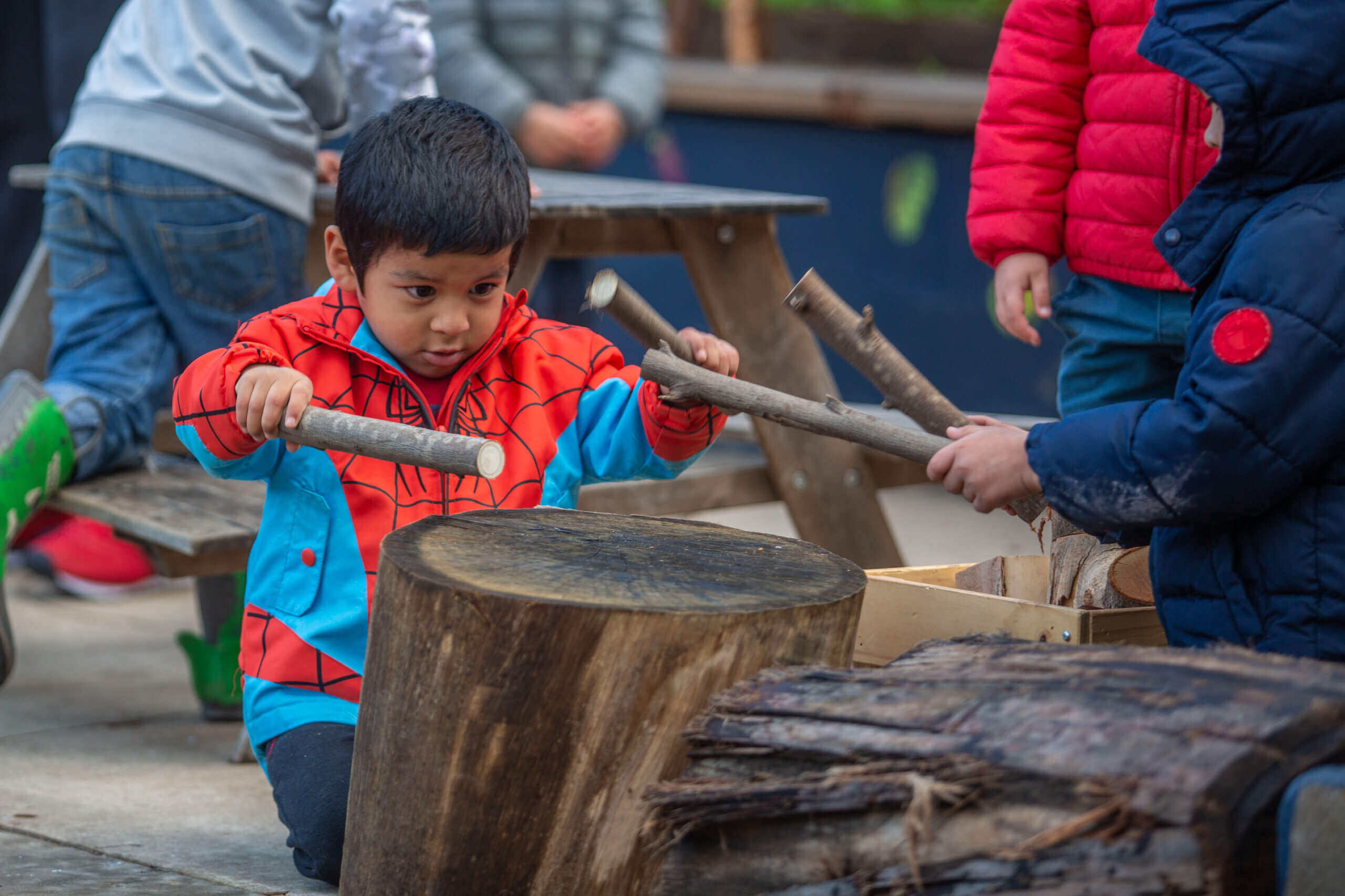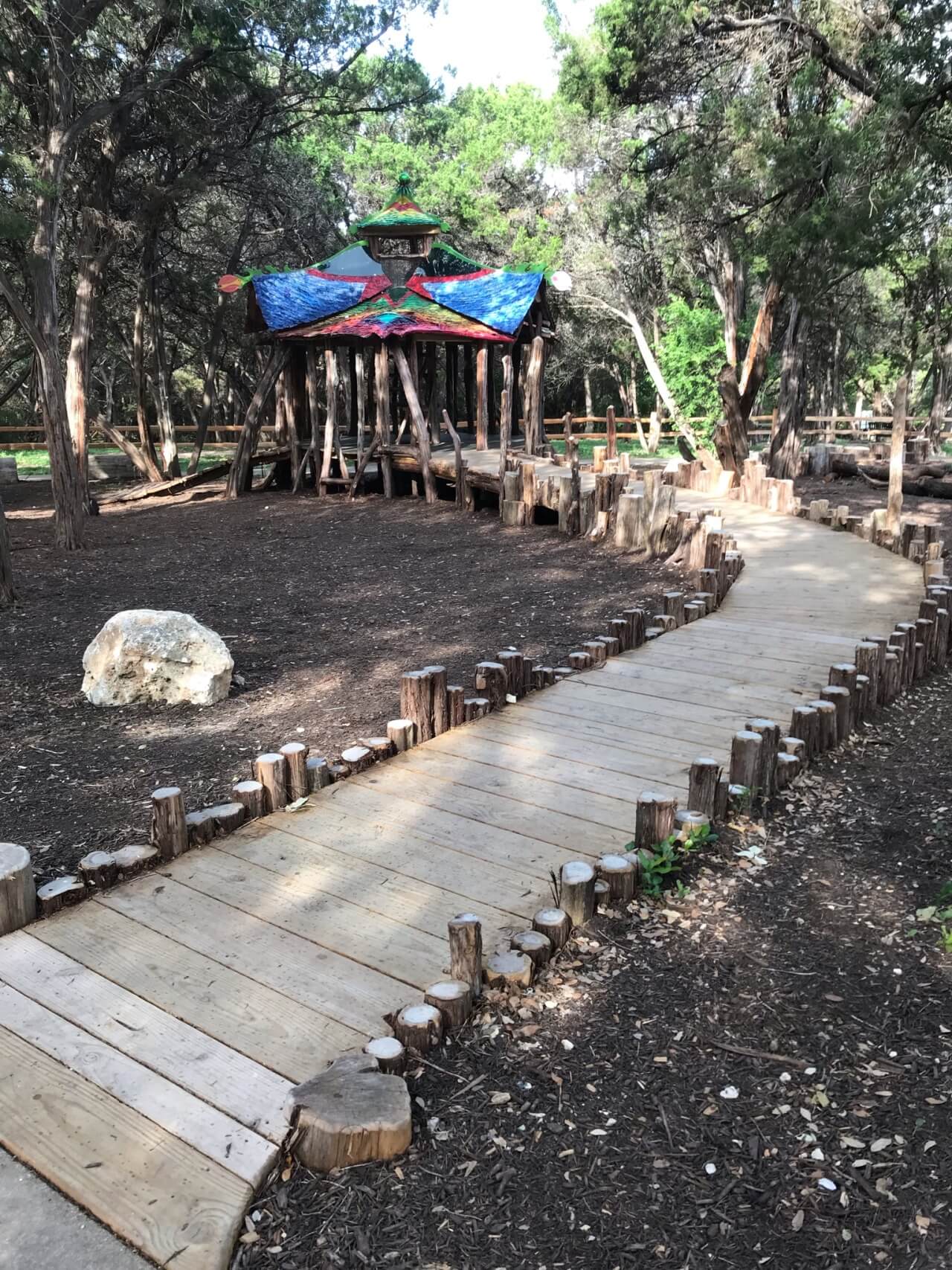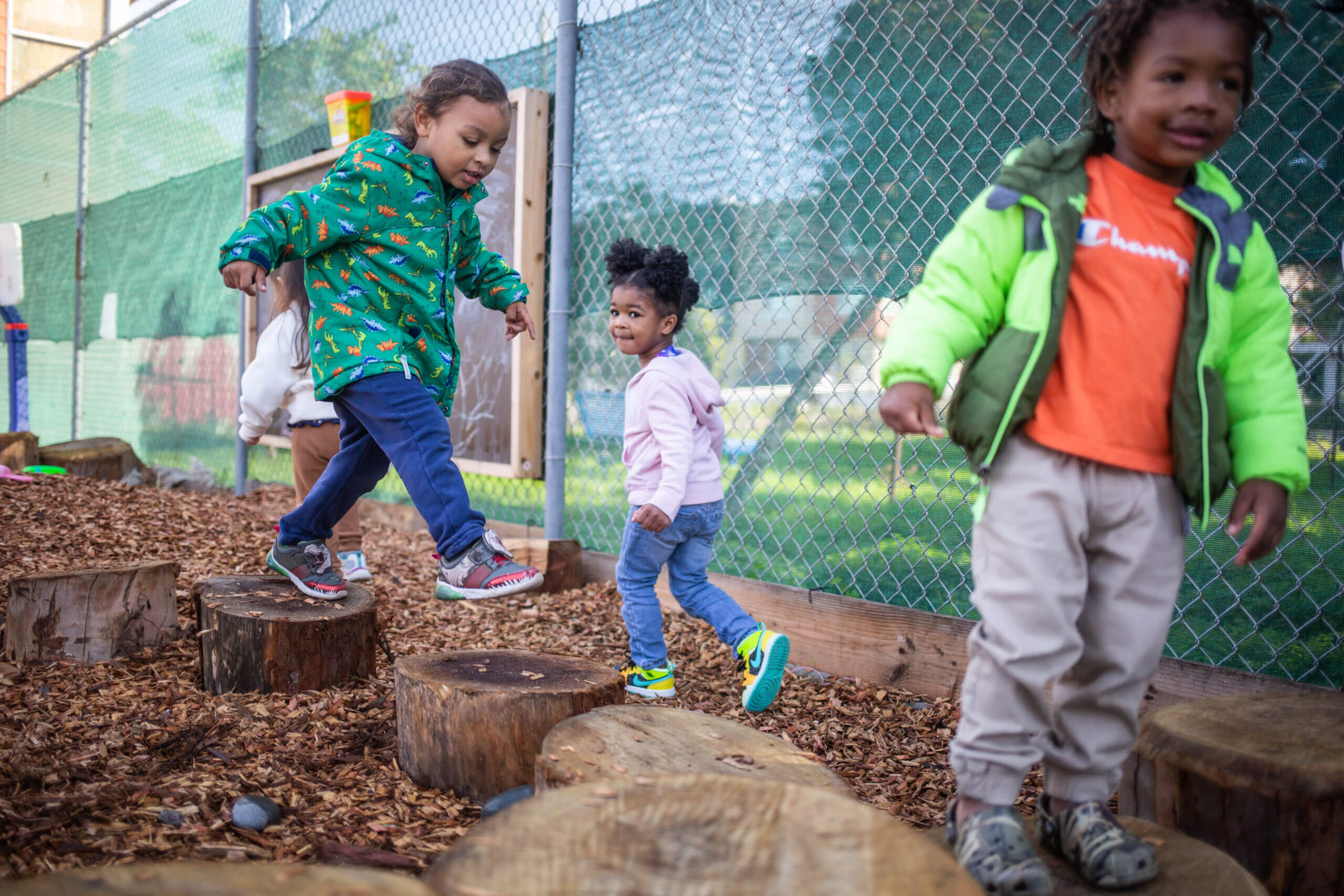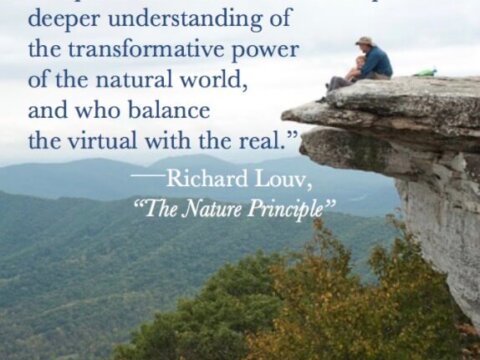Stumps, jumps and tree cookies: Bringing nature’s benefits to young children in cities
A 4-year-old boy pounds a branch on a round slice of tree trunk, known as a “tree cookie.” Realizing he can make music, he smiles and begins to pound in rhythm. Across the yard, another group of preschoolers follow a teacher along a log on the ground. The kids hold their arms wide, balancing and following directions. Ahead of them are children who are jumping from rock to rock, squealing as one kid yells “ground is lava!”
This scene doesn’t happen out in a forest or far off in a distant natural environment. It can–and does–happen in the hearts of cities across the country, adjacent to concrete yards and parking lots. Outdoor experiences like this happen because city leaders bring together collaborative teams who understand the importance of connecting young children to nature on a regular basis.
“The ages of zero to five are such a foundational time in a child’s life,” said Vera Feeny, Senior Program Specialist, Children and Nature at the National League of Cities (NLC). “We know that time in nature offers many benefits. Young children living in cities deserve access to these benefits.”
Across the U.S., cities are working to connect kids to nature during their early developmental years, inspired by research indicating that providing young children, ages zero to five, with regular access to nature improves physical and mental health, develops social emotional skills and better prepares children for school. It also helps children develop connections to nature and their communities.
“The benefits of nature connection align with many city priorities,” said Feeny. “Nature-based benefits complement and support goals related to education, equity, sustainability, community health, park expansion and so much more.”

Photo courtesy of Maria Durana, San Francisco Children & Nature
Pathways to nature
What are cities doing to support early childhood development? A national review by Cities Connecting Children to Nature (CCCN), an initiative of the Children & Nature Network and the National League of Cities, found that communities are bringing nature to children in places where they live, play and learn through four main pathways:
- Enhancing parks and public spaces with natural elements such as boulders, logs and paths to encourage hands-on unstructured nature play.
- Adding nature to outdoor spaces at early childhood centers and preschools, as well as family, friend, and neighbor-based child care.
- Incorporating nature-based programming at city facilities, such as libraries and recreation centers.
- Supporting nature preschools, which use outdoor learning strategies to teach content across a wide range of curriculum.
The CCCN review also found that city leaders understand the critical role that early childcare professionals and families play in connecting young children to nature. So, cities also focus on professional development, family engagement and policies that support these efforts. A newly available CCCN technical assistance opportunity will support cities as they look to incorporate these pathways to nature connection into their city plans.
Madison, Wisconsin: Bringing nature to child care centers
One such example is in Madison, Wisconsin, which joined the CCCN initiative in 2017 as a pilot city. Nearly one-third of Madison’s children under the age of 5 attend child care centers accredited by the city. Two in five of these children are children of color, who have historically lacked access to nature. So, the city decided to focus on bringing nature to child care centers. The Madison CCCN team set and achieved a goal of identifying seven centers to receive funding and technical assistance to add natural elements to outdoor spaces. They applied an equity lens by selecting early childhood programs with less green space and those that enrolled 50% or more of children with subsidized payment plans.

The Nature Nook at Brittingham Park in Madison, Wisconsin, is a nature-based play area within a local park, made possible through a Connecting Children to Nature grant and partnerships across the city.
“Both the public health department and the parks department in Madison had an understanding of the importance of that zero to five age in regards to charting a path forward in life,” said Justin Svingen, planner at Public Health Madison and Dane County. “With the support of CCCN, we embarked on a plan to add physical space improvements, enhance our policies, and facilitate increased time in nature, in the places we knew young kids visited such as childcare centers, parks, rec centers and preschools.”
“The public health department brought their experience with community engagement, particularly related to families and children, and the parks department brought their technical expertise and supply of natural materials,”said Svingen. “It’s been a win/win for the city’s young children.”
Austin, Texas: Making nature part of the plan
In Austin, another CCCN pilot city, the goal was to find ways to incorporate natural elements – or nature play – into its current planning processes, instead of something that was seen as a new or additional project. “Once the city acknowledged its belief that all children have a right to nature’s benefits through its Children’s Outdoor Bill of Rights, then the question was ‘how do we go about doing that as part of our regular planning process?’,” said Melody Alcazar, Cities Connecting Children to Nature Coordinator from the City of Austin Parks & Recreation Department.
To support these efforts, Austin’s CCCN team focused on a number of activities to help shift the way people think about nature play before adding nature play spaces into parks and early childhood facilities. “One of the biggest perceptions we’re trying to shift is getting people comfortable with the idea that playing in nature is just as safe as playing on a traditional playground or on a soccer field,” said Alcazar.

A fairy pavilion is part of the nature play space at Walnut Creek Metropolitan Park, Austin's first and largest natural play space area.
The Austin CCCN team started their process with a series of professional development workshops for educators. They then incorporated nature play elements into park planning guides to get people used to seeing the features. They also worked with local landscape designers to receive training on designing with nature connection and outdoor learning in mind. More recently, they are finalizing nature play guidelines focused on safety and maintenance staff.
The results in Austin have meant that ten city parks offer nature play spaces and another two parks are planning to add nature play. In addition, four Austin early childcare centers currently participate in a state-wide effort to add nature to early childhood outdoor spaces through the Outdoor Learning Initiative! (OLE! Texas).
San Francisco, California: Collaboration for nature connection
Another CCCN city leading the efforts in early childhood nature connection is San Francisco, California. “Our San Francisco Children & Nature initiative is 5 years old, so it has been some time since we started planting the seeds of partnership within our city,” said Maria Durana, Director of the San Francisco Children & Nature collaborative within the San Francisco Recreation & Park Department. “Relationships take time and through various collaborations we’ve been working on building strong partnerships between the parks, community organizations, and the early childhood community.”
Those efforts have paid off for young children in San Francisco. While the city’s efforts started small – doing nature play days in parks and early childhood centers – current projects have grown in scope and impact.This past year, the initiative partnered with the Low Income Investment Fund, led by Elizabeth Winograd, Senior Program Officer, to execute major changes to four early childhood centers and five family child care homes, raising $300,000 for the project.
“By working together we’ve been able to more equitably serve child care centers that might have less access to nature and need more resources,” said Winograd. “Through collaborations and partnerships, we are now able to really change the spaces to make sure that kids can play and learn in nature, even in what used to be a concrete yard.”

Photo courtesy of Maria Durana, San Francisco Children & Nature
Technical support and peer learning pay off
Like the city of San Francisco, Madison and Austin didn’t start off knowing all the answers or having all the resources. It took time, training, and a lot of support from technical experts in the field and connections from other CCCN cities who’d embarked on similar paths.
“The CCCN initiative really gave us an opportunity to access national experts, folks who could walk us through environmental evaluation tools to help us assess the physical environment at these early learning centers and understand what we can add to them,” said Svingen from Madison. “And the amount we were able to learn from other partner communities was really beneficial.”
In Austin, Alcazar agrees. “Seeing what other cities are doing is really a kind of justification for yourself. It’s so helpful to see how other cities are progressing. And, it’s really helpful to show our leadership other examples across the country; for them to know that Austin isn’t a one-off, but part of a larger national effort.”
The Cities Connecting Children to Nature initiative is currently inviting additional cities to join that national effort. CCCN invites cities to apply to receive technical assistance to activate city leadership to launch, or expand, strategies to connect young children to nature more equitably. The new Early Childhood Nature Connection program will launch in late Spring of 2022. Applications are due Friday, March 18, 2022. Apply and learn more about how to bring nature’s benefits to young children in your city.
San Francisco Children & Nature set up design jams as community engagement events to gather ideas from local children for a new nature exploration area.
NEW: Early Childhood Nature Connection Opportunity for Cities
Benefits of Nature for Early Childhood: An Infographic
Nature Play Spaces: A Visual Tour (VIDEO)
Strategy Tool: Nature Connection in Early Childhood Education
Systems Change: A Toolkit for Cities
Seeds to Blooms: A Report on Nature-based Early Childhood Education at Antioch University
Summary of Evaluation Findings: Anitoch University New England’s Nature-based Early
-
Network News
Earth Day: Young leaders advocate for change
-
Feature
Nature photographer Dudley Edmondson has a vision for the representation of Black and Brown faces in the outdoors
-
Richard Louv
EARTH MONTH: You're part of the New Nature Movement if....
-
Voices
Placemaking: How to build kinship and inclusive park spaces for children with disabilities
-
Network News
Children & Nature Network founders release report on global factors influencing the children and nature movement






